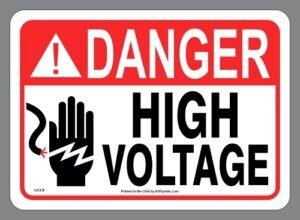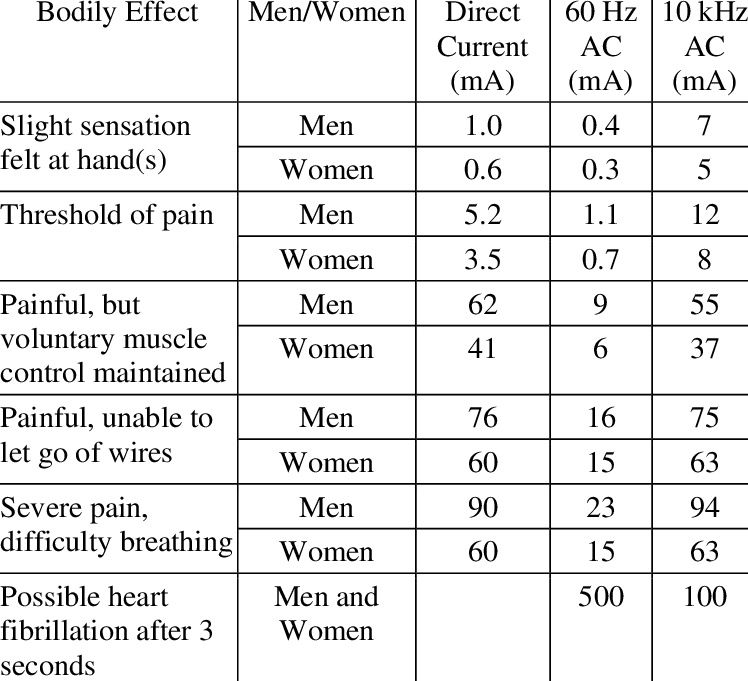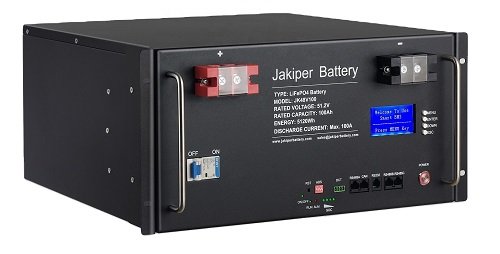Whenever you perform an off-grid solar installation, you should be as careful as with any other electrical installation. A 48V DC battery system from an off-grid PV system should not kill you. BUT under the right circumstances, it can.
That’s why it is important to properly manage the installation with caution.
If you are installing a solar panel system by yourself, you should know the dangers and safety requirements for the installation. In this article, we explain the voltage and current levels that might kill you, the most dangerous type of current, the electrocution consequences for the human body, and more.
Is Low Voltage Dangerous for You?
Low voltage is present in many off-grid solar systems. Battery banks can operate at 12V or 24V, but they usually do so at 48V for larger systems. That’s why it is important to analyze the safety or danger of this low voltage.
The safety threshold for an electric shock can be set at 50V and 5 mA for AC. For DC it is set at 120V.
Current vs. Voltage: Who Is the Real Killer?
There are discussions stating that the current is the only aspect that kills. In truth, high voltage can be as dangerous as current. But the literature about safety refers to current as a threshold for fibrillation. There is a reason why there is a warning for high voltage and not high current.

High voltage (>1000VAC) with a low current of 5mA can result in electrical burns, muscle damage, nervous systems damage, and others. Voltage levels can be considered as low and safe under 50VAC or 120VDC, as long as the current levels are also low.
But there is a kicker: the amount of current that flows through your body depends on the voltage. Thus, high voltage is more dangerous than low voltage is true.
I = U/R
I = 50V/10,000 ohm = 0.005A -> 5mA
I = 120V/10,000 ohm = 0.012A -> 12mA
Here is a good video about it:
There is a difference between AC and DC, we will talk about that next.
DC or AC: What Is the Worst Type of Current?
It is said that AC is up to five times more dangerous at the same voltage levels than DC, especially at low frequencies of 50 Hz – 60 Hz. The reason for this is because DC produces a single convulsion or muscle contraction, which pushes the victim away from the DC voltage source, meanwhile, AC produces tetany, more intermittent muscular spams that freezes you and keeps you stuck to the naked wire or electrified surface.

AC also affects the heart directly and more dangerously. A DC electric shock can cause a Cardiac Standstill, which is when your heart suddenly stops. AC on the other hand can produce constant contractions at your heart, causing Atrial Fibrillation, which is fatal.
The reason for this is that DC will increase the resistance of the skin. This will lower the current that goes through your body. And that’s why 120VDC is considered safe.
Dangers of Electricity for Your Body
Electrocution can cause electrical burns, muscle damage, nervous system overload, and other consequences. While a low voltage can cause a simple muscle spasm, high voltage and especially high currents produce dangerous problems like:
- Cardiac arrest
- Tissue burning
- Organ damage
- Nervous system problems
- Single organ consequences
These are all consequences that can be produced at low voltages (<1000V). Extremely high voltage and high currents can completely blow parts of your body when surpassing the 1000J.
48V DC Battery Example

When you have a server rack battery of 48VDC and touch the terminal with your hand, a current will flow. Your resistance will decide if you will get a shock or not.
The human body has different resistance (impedance) depending on the skin’s condition.
The internal impedance of the human body is about 500 ohms. But the skin impedance depends on moisture and more importantly on voltage.
The resistance of the human body to DC current is higher than the AC current. So working on a 48V DC battery will be safer than working on 48V AC.
Let’s say the body has a resistance of 10,000 Ohms and the 48V battery is fully charged.
58 VDC/10,000 Ohm = 0.0058A -> 5.8mA
This current will give you a tingling sensation. However, when the circumstances are bad and your resistance is lower it can end badly. If you increase the moisture on your skin or have a wound that makes it easier for the current to penetrate your skin, the results are very different.
58 VDC/3,000 Ohm = 0.019A -> 19mA
This current will be very painful but you will still be able to let go of the wire.
My advice: You need to be safe and use rubber gloves. Make sure you are properly insulated from the floor.
Conclusion
As we have learned, both electrical current and voltage are dangerous. In an off-grid solar system, the battery bank is generally sized at 48VDC. This can be considered low-voltage and safe under the right conditions. However, in the worst case, it can kill you if your body resistance is low.
We must not forget the potential energy stored in the battery. It’s ready to discharge hundreds of amps at your face when you drop a tool on the terminals. It doesn’t sound appetizing, but you need to be aware of this. The same can happen with 12V batteries.
This is why it is highly recommended to use proper protective equipment and also include protection devices in the design that can detect a fault in the system and potentially save you from receiving a fatal electrical shock or starting a fire.
Tips and protection devices:
- Wrap your tools in electrical tape
- Wear safety goggles
- Use insulating gloves
- Make sure your wear proper shoes
- Use fuses to protect your system from short circuits
Frequently Asked Questions (F.A.Q.)
Why can metal surfaces in appliances be dangerous?
The metal surface of appliances like washing machines requires a ground phase to properly work. Using these appliances without earthing or electrical grounding at the home is an electrocution hazard. These metal surfaces’ insulation can fail, become electrically energized and discharge electricity onto the user, which is why it is always recommended for homes and equipment to be properly grounded.
What is the safest array configuration for your off-grid system?
The safest array for grid-tied or off-grid systems can still feature high voltages. While high voltage represents an electrocution hazard, DC high voltage is not as dangerous as AC high voltage. Considering this, we recommend using a solar array configuration with the highest string voltage up to 120VDC if safety is your main concern. However, it’s best to get the voltage as high as possible to the maximum input voltage of the charge controller for efficiency reasons. Keeping the voltage under 120VDC is considered extra-low voltage.
What should I wear when performing electrical repairs at my home?
To perform electrical repairs at your home, we recommend wearing safety gear and to remove any jewelry or any metal accessories. Using silicone gloves, a long-sleeved shirt, safety glasses, and proper shoes (insulated) will be more than enough to provide you with safety during the installation or repair. If you are dealing with high voltages, we also recommend using arc-rated pants and an electrical face shield, to protect you from electrical arcing burns.
How many batteries do I need to go off-grid?
The amount of batteries depends on your daily consumption. Use our calculator to find out your daily use here and read my article about it here.
Is 48V better than 12V?
I have written an article about this question with all the advantages. You can read it here.
 I have written a book that contains all the information you need to get started with off-grid solar power.
I have written a book that contains all the information you need to get started with off-grid solar power.
With over 1,400 reviews at 4.5 stars, I can almost guarantee that this book will save you $100’s on buying the right equipment.
You can buy it here on Amazon.com

I’m an off-grid enthusiast. I created this website to give clear and straight-to-the-point advice about solar power. I’m also the author of the book ‘Off-grid solar power simplified‘. Read more about me on my about page, check out my Youtube channel, or send me a message.